South Korea Dominance Factors: Key Elements Behind National Success
Updated On: November 13, 2025 by Aaron Connolly
Core Foundations of South Korea’s Dominance
South Korea went from a war-ravaged country to a global powerhouse, and three main reasons explain this: fast economic growth after the Korean War, its strategic spot in East Asia, and strong leadership. These pillars set the stage for South Korea to become a big player in the region.
Post-War Economic Transformation
South Korea’s economic miracle kicked off in the 1960s with focused government planning. The country moved away from farming, embraced heavy industry, and then pivoted to technology and manufacturing.
The chaebol system drove much of this change. Huge family-run groups like Samsung and LG got government support and built industries from the ground up.
Leaders pushed export-driven policies. They zeroed in on:
- Steel production
- Shipbuilding
- Electronics manufacturing
- Automotive production
Investing in education made a huge difference. The government poured resources into technical training and universities. That created a workforce ready for high-tech manufacturing.
Foreign investment also played a role. Japanese and American firms shared their know-how in exchange for access to Korean markets.
By the 1980s, Seoul buzzed as a financial hub. The economy just kept climbing, with growth rates topping 8% a year for decades.
Strategic Geographical Position in East Asia
The Korean Peninsula sits smack in the middle of major powers. That location shapes South Korea’s influence—and its headaches.
Maritime access gives the country control over important shipping lanes. With coastlines on both the Yellow Sea and the Sea of Japan, South Korea sits on vital trade routes between China and Japan.
Seoul’s location brings both chances and risks. The country constantly juggles relationships with:
- China (its biggest trading partner)
- Japan (a historical rival and security ally)
- United States (military partner)
- North Korea (ongoing conflict, obviously)
Buffer zone dynamics keep things tense. South Korea stands as a democratic counterweight to its authoritarian neighbors. That draws Western support but also piles on security challenges.
Most South Koreans live in or around Seoul. This urban sprawl drives innovation but also makes the city vulnerable.
Resource shortages force creative thinking. Because South Korea imports nearly all its energy and raw materials, it built an export-focused economy and sought out strong alliances.
Role of Leadership and Governance
South Korea’s shift to democracy in 1987 changed everything. Civilian leaders replaced generals, and the country got stable institutions.
The presidential system puts a lot of power in one person’s hands, but single five-year terms stop anyone from holding on too long. Each new president brings a different approach to the China-US rivalry.
The National Assembly keeps the executive branch in check. With multiple parties, there’s always debate about foreign policy and alliances.
A professional bureaucracy keeps things running smoothly, even when leadership changes. Ministries like Foreign Affairs and National Defence hold onto institutional memory, which helps when navigating tricky relationships with neighbors.
Civil society stays active. Public opinion can sway government moves on things like military deployments or trade deals.
Judicial independence keeps leaders honest. Courts have even impeached presidents for corruption, showing that accountability isn’t just talk.
Technological Innovation and Research
South Korea’s technological dominance comes from massive R&D investments. The country shifted from importing tech to leading in semiconductors, electronics, and AI, thanks to smart government support and private sector drive.
Focus on Research and Development Initiatives
South Korea spends over 4.5% of its GDP on research and development. That’s among the highest globally. The government set up specialized research hubs like Daedeok Innopolis in Daejeon.
This place brings together hundreds of research institutes and tech startups. Major universities team up with private companies. Samsung, LG, and Hyundai all run gigantic R&D centers.
Government R&D Investment Areas:
- Semiconductor technology
- Artificial intelligence
- Telecommunications infrastructure
- Robotics and automation
- Green energy
Universities and industry work together closely. The Korea Advanced Institute of Science and Technology (KAIST) partners directly with big companies, creating a pipeline from the lab to the market.
The Institute for Basic Science gets hefty government funding for breakthrough research. Private companies match these investments with their own R&D budgets.
Advancements in Semiconductors and Electronics
Samsung dominates global memory chip production. They lead in DRAM and NAND flash memory. LG runs the show in display tech, especially with OLEDs.
South Korea makes over 60% of the world’s memory chips. Samsung’s factories use cutting-edge 3-nanometre tech, staying ahead of much of the competition.
Major Korean Semiconductor Companies:
- Samsung: Memory chips, processors, foundry services
- SK Hynix: Memory solutions, storage devices
- LG Display: OLED panels, LCD tech
Korean firms keep pouring billions into new chip plants. Samsung recently announced a $17 billion plant in Texas. SK Hynix keeps growing its global footprint.
Electronics go way beyond chips. LG makes smart home appliances you’ll find everywhere. Samsung leads in TVs and smartphones.
The government sweetens the deal with tax breaks for R&D. The K-Semiconductor Belt project links research, manufacturing, and testing, aiming to strengthen the whole supply chain.
Artificial Intelligence and Emerging Technologies
Korean companies jump on AI fast. Samsung bakes AI into phones and appliances. LG uses machine learning to improve displays and manufacturing.
The government rolled out the Korean New Deal, funneling big money into AI research centers and startup incubators. Top universities now offer specialized AI programs.
AI Application Areas:
- Manufacturing automation
- 5G networks
- Gaming and entertainment
- Healthcare diagnostics
- Self-driving vehicles
Hyundai works on self-driving cars with tech partners. Their robotics projects go beyond just cars.
AI startups in Korea now attract serious venture capital. Gaming companies like NCSoft use AI to develop new games. Telecom firms rely on AI to optimize their networks.
Regulations sometimes slow things down, especially in fintech and mobility tech. The government is trying to find a balance between innovation and consumer safety.
South Korea led the world with early 5G rollout. That infrastructure now supports advanced AI and IoT projects.
Major Industries and Conglomerates
South Korea’s economy runs on giant family-run groups called chaebols. These conglomerates control key sectors like electronics, cars, and telecom. The top 10 chaebols make up about 60% of the country’s GDP.
The Influence of Chaebols: Samsung, LG, and Hyundai
Chaebols, basically big family businesses, run the show in South Korea. The term combines ‘wealth’ and ‘clan’—makes sense, right?
Samsung started as a tiny grocery shop in 1938. Now it’s worth over $50 billion and accounts for 20% of Korea’s GDP. They make everything from phones to memory chips.
LG leads in home appliances and electronics. Their products fill homes around the world, from washing machines to fancy TVs.
Hyundai Motor Group owns almost 40% of Korea’s car market. They run Kia, Hyundai, and Genesis. In 2022, every best-selling car in Korea came from Hyundai.
These three giants employ millions. They also own smaller firms in finance, construction, and retail. Their success powers Korea’s exports.
| Chaebol | Founded | Main Industries | GDP Contribution |
|---|---|---|---|
| Samsung | 1938 | Electronics, semiconductors | 20% |
| LG | 1947 | Electronics, chemicals | 8% |
| Hyundai | 1967 | Automobiles, finance | 12% |
Global Leadership in Electronics and Automobiles
South Korean companies lead in tech. Their products go toe-to-toe with American and Japanese brands.
Electronics? Samsung and LG are at the top. Samsung makes the best memory chips and phone screens. LG’s OLED TVs and monitors are everywhere. Both companies invest billions in research.
Cars? Hyundai and Kia sell about 7 million vehicles worldwide each year. Their electric cars now compete with Tesla and BMW.
Telecom? SK Telecom serves nearly half of Korea’s mobile users. They even export network tech to other countries.
Hyundai Heavy Industries leads in shipbuilding, building 40% of the world’s commercial ships.
These industries bring in a trade surplus of over $30 billion each year. Heavy research investment, skilled workers, and government backing keep them ahead.
Innovation Culture and Disruption
South Korea’s innovation story isn’t simple. The country wrestles with old-school corporate traditions and new waves of disruption. Moving from top-down research to scrappy entrepreneurship isn’t easy, especially with rules that can sometimes choke off bold new ideas.
Start-up Ecosystem and Entrepreneurial Spirit
The start-up scene in South Korea faces some real hurdles, even with big government spending. Surprisingly, adults here rank near the bottom globally when it comes to seeing start-up opportunities.
Fear of failure runs deep. Many entrepreneurs focus on short-term wins instead of taking big risks. That leads to small improvements, not game-changing innovation.
The stats don’t lie. South Korea spends nearly 5% of GDP on R&D—second highest in the world—but that hasn’t sparked a start-up boom.
Major Korean platforms have lost £40 billion in value lately. This drop points to big structural issues in scaling and competing on the global stage.
Key barriers:
- Tough access to global markets
- Cautious corporate culture
- Uncertain regulations
- Most resources stuck with the big chaebols
The government knows about these problems. New policies aim to help start-ups, but changing the culture will take a while.
Role of Organisations and Bureaucracy
Korean bureaucracy works through a dual system that can box in innovation. “Positive regulation” means businesses need explicit permission to try new things, unlike the Western approach where only banned activities are off-limits.
This slows everything down. Companies sometimes wait ages for approval to launch new tech or business models.
Shadow regulations add more hurdles. These aren’t laws, but “administrative guidance” that still shapes what companies can do.
Look at crypto. Financial authorities told banks not to issue corporate accounts for crypto, effectively limiting the industry to basic functions.
Organisational challenges:
- Slow decision-making
- Lots of hoops to jump through
- Unofficial regulatory roadblocks
- Pressure from established industries
Big chaebols still call the shots in innovation spending. Their R&D teams focus on small upgrades instead of major breakthroughs.
Government agencies sometimes trip over each other when it comes to tech policy. This mix-up sends confusing signals to companies hoping to innovate.
Disruption and Adaptability in Business Practices
Korean companies keep running into serious disruption from global rivals, especially Chinese firms making big moves in AI and digital platforms. The old regulatory system, once a badge of manufacturing excellence, now gets in the way of digital progress.
The TADA ride-sharing saga really highlights how disruption can get crushed. TADA won every court battle and had plenty of public support, but political pressure still forced the “TADA Prohibition Law” through in 2020.
Current disruption patterns:
- Crypto firms are packing up for Dubai and Singapore
- AI developers are stuck waiting for new regulations
- Platforms have to slog through endless approval steps
- Traditional industries push back against fresh competition
Korean businesses know how to follow proven tech paths. But digital innovation? That needs a whole new playbook—one that invents new models and even new markets.
Chinese competitors keep moving forward while Korean companies wait for regulators to catch up. This hesitation really hurts in industries where being first means everything.
The government says updating regulations could lift GDP by £800 billion by 2040. If Korea doesn’t act, it could end up dead last among OECD countries for growth by 2031.
Warning: The clock’s ticking. Global competitors are locking in their lead in emerging tech, and that gap might soon be permanent.
Marketing Strategies and Global Branding
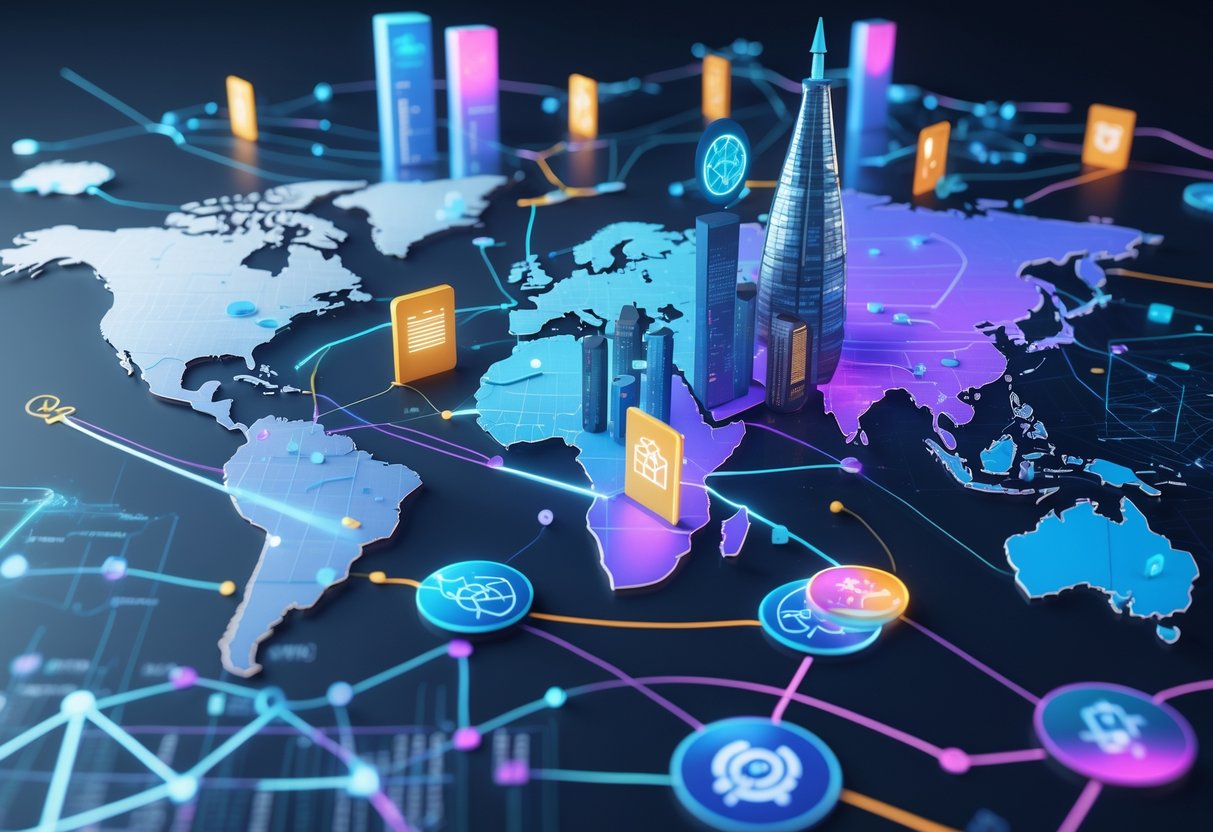
South Korean companies have scored global wins with clever marketing that actually connects with people around the world. They invest in strong brand identities that stick in your mind—and earn trust.
Global Marketing and Promotional Campaigns
Samsung and LG show what it looks like to think global from day one. They don’t just tweak local ads for other countries. Instead, they build campaigns that work across cultures.
Digital-First Approach Korean brands turn to social media—TikTok, Instagram, YouTube—to reach younger crowds. Their content feels real, not like some faceless ad.
K-beauty brands like COSRX and The Ordinary exploded in popularity by teaming up with influencers who actually use their stuff. That’s how they build genuine customer trust.
Cultural Adaptation Without Losing Identity Korean companies tailor their message for each market but stick to their core values. Take Samsung: their phone ads look different in Europe and Asia, but the quality message always comes through.
Cross-Industry Marketing Korean brands love to team up. K-pop stars flash Samsung phones in videos. LG puts K-drama actors in appliance commercials. It’s a “Korean wave” that lifts everyone.
Customer Trust and Brand Identity
Korean brands play the long game. They’d rather build lasting relationships than chase quick wins. Trust takes time, but loyal customers will spread the word for you.
Quality Over Price Competition Samsung goes head-to-head with Apple on features and quality—not just price. LG leans into innovation and reliability. This strategy builds a premium image.
Transparency and Communication Korean companies jump on customer feedback fast, especially on social media. They own up to mistakes and fix them in public. That kind of honesty wins people over.
Consistent Brand Experience From packaging to support, Korean brands keep the quality steady. Buy a Samsung gadget in London or Seoul, and you’ll get the same experience.
Community Building Korean brands love building communities. Riot Games (yep, Korean-owned) has massive player groups that hype the brand on their own.
This commitment to authentic relationships over pushy sales has made Korean brands favorites with customers worldwide.
Trade Agreements and Economic Cooperation
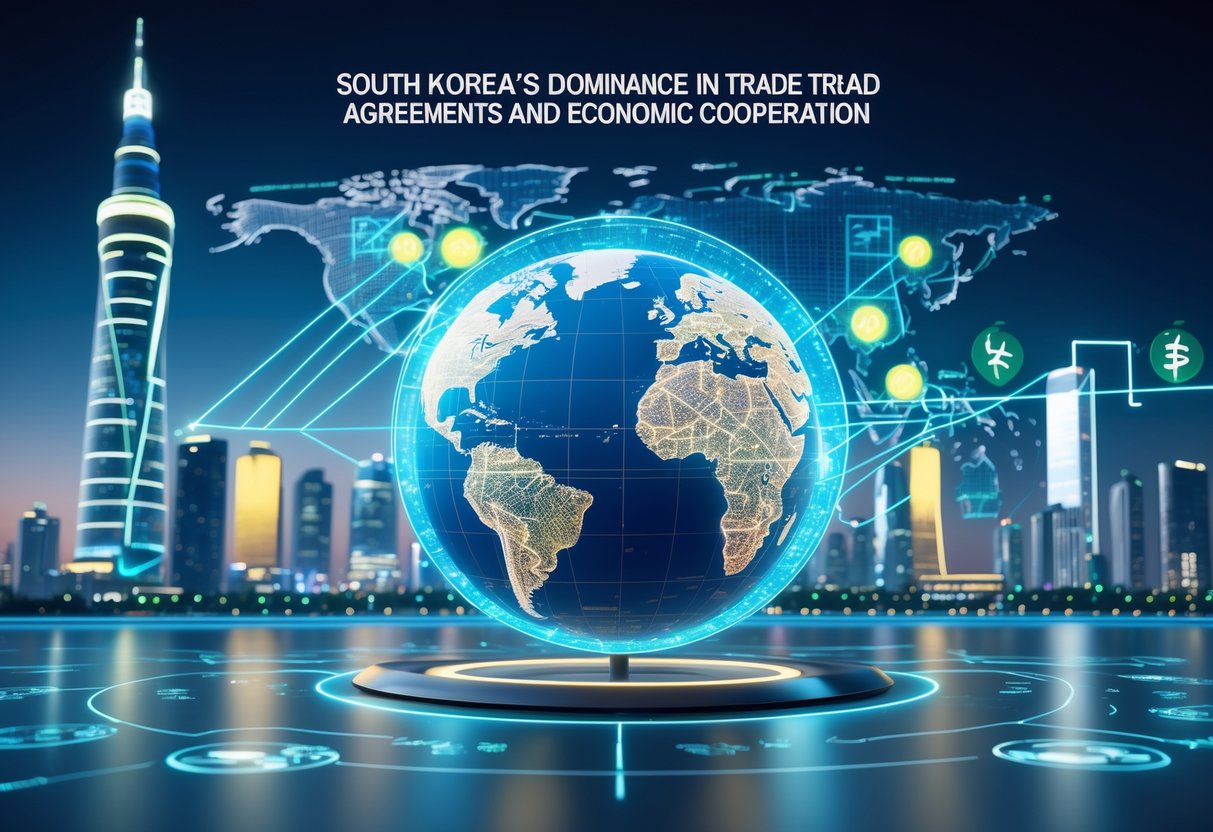
South Korea built its economic muscle with sharp export policies, a web of free trade agreements with big partners, and active roles in global organizations that steer commerce.
Export-Oriented Economic Model
South Korea transformed itself by betting on trade. Exports and imports now make up over 70% of the $1.8 trillion economy.
We can see this model in action in semiconductors, shipbuilding, cars, and steel. Together, these sectors make up about a quarter of the country’s GDP. They’ve become global leaders by focusing on export strategies.
The country moved away from protectionism in the 1990s under US pressure. This shift pulled Korean companies deeper into global value chains. It was tough but crucial for long-term growth.
Key Export Markets Evolution:
- 1990: US took 29.8% of exports
- 2018: China peaked at 26.8%
- 2023: China at 19.7%, US at 18.3%
Diversifying like this? It’s just smart. Korea avoided putting all its eggs in one basket.
Strategic Trade Partnerships
Since 2003, South Korea has built a strong network of free trade deals. In just ten years, they signed 15 FTAs covering over 85% of their trade.
The KORUS FTA with the US kicked off in 2012. By 2024, South Korea became America’s seventh-biggest trading partner. The US now ranks second for Korea, right after China.
Regional deals matter a lot, too. The 2006 ASEAN agreement opened doors in Southeast Asia. South Korea joined RCEP as a founding member and applied for CPTPP in December 2021.
Major FTA Partners Include:
- All top five trading partners except Japan
- ASEAN bloc
- European Union
- Lots of bilateral deals worldwide
These agreements slashed tariffs and trade costs. They let Korean firms compete globally while still shielding some domestic industries.
Impact of International Organisations
South Korea uses its spot in big international groups to boost its economic standing. Joining the OECD in 1996 opened doors to developed nation networks.
WTO membership gives Korea a way to resolve trade disputes. The country also signed onto agreements like TRIPs for intellectual property and the Government Procurement Agreement for public contracts.
These memberships give Korea a say in setting global trade rules. The country acts as a bridge between economic blocs thanks to its middle power status.
Key Benefits:
- Access to dispute resolution
- Influence on trade standards
- Connections with developed economies
- Technical help and best practices
International cooperation lets Korea juggle ties with both the US and China, keeping trade strong with both.
Geopolitical Dynamics on the Korean Peninsula

The Korean Peninsula sits right where big powers clash for influence, making it one of East Asia’s most strategic spots. North Korea’s nuclear ambitions, the legacy of the Korean War, and ongoing US-China rivalry all shape South Korea’s position and regional stability.
Relations with North Korea
The North-South relationship still defines Korean Peninsula politics. Technically, the two countries are still at war—they only signed an armistice in 1953, not a peace treaty.
Nuclear tensions drive the relationship. North Korea’s nuclear weapons pose a real threat to the South, forcing Seoul to rely on US military protection and missile defense.
Economic cooperation happens sometimes. The Kaesong Industrial Complex showed that collaboration is possible, but political tensions keep shutting these efforts down.
Diplomatic efforts come and go. Summits in 2000, 2007, and 2018 sparked hope, but talks usually stall over nukes and outside pressures.
This division limits South Korea’s strategic freedom. Seoul has to balance hopes for peace with real security worries.
Historical Context: Korean War and Aftermath
The Korean War (1950-1953) set the stage for today’s geopolitics. The conflict brought in outside powers, and that involvement still hasn’t gone away.
Foreign military presence became the norm. US troops stayed to guarantee security, cementing military ties but also limiting Korea’s independence.
Ideological division got worse during the Cold War. The peninsula turned into a frontline between communism and capitalism—a split that’s still here.
Alliance structures grew out of the war. South Korea’s partnership with the US became its security backbone, while China’s support for North Korea created a rival sphere of influence.
The war’s unresolved status keeps regional diplomacy tricky. The armistice means international players are still needed to keep things stable.
Influence of Regional Powers
China is South Korea’s top trading partner and backs North Korea politically and economically. Beijing wants stability but doesn’t want US troops near its borders.
The United States keeps about 28,500 troops in South Korea and offers nuclear deterrence. Washington wants to stop North Korea’s nukes and counter China’s influence.
Japan plays a big role too, even with its rocky history with both Koreas. Tokyo works with Seoul on North Korea but has its own security concerns.
Russia doesn’t have as much sway, but its influence is growing, especially through energy deals and diplomacy. Moscow usually sides with China on peninsula issues.
All these overlapping interests create a complicated web. South Korea has to tread carefully to stay secure and prosperous.
Diplomacy and Foreign Policy Initiatives
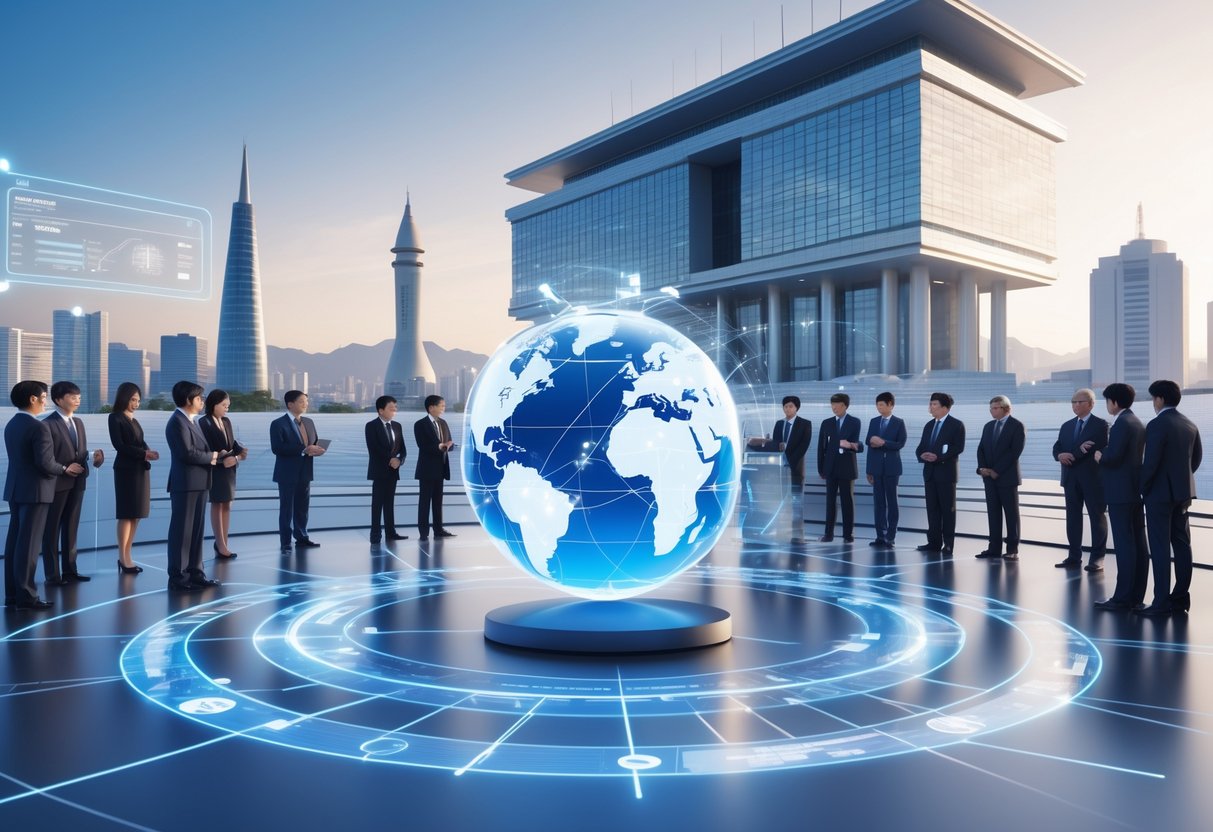
South Korea builds strategic partnerships across the Indo-Pacific while practicing middle power diplomacy to balance big players. Its stance on Taiwan Strait tensions and regional security shapes its growing global influence.
Indo-Pacific Strategy and Belt and Road Initiative
South Korea’s Indo-Pacific strategy zeroes in on economic cooperation and security partnerships. Seoul works closely with ASEAN nations through multilateral channels.
The country takes a practical approach to China’s Belt and Road Initiative. South Korea joins a few BRI projects but makes sure to keep its independence.
Key diplomatic priorities include:
- Strengthening trade with Southeast Asia
- Balancing economic ties between the US and China
- Backing maritime security efforts
The Moon Jae-in administration played “strategic ambiguity” between major powers. This gave Korea room to build economic ties while keeping security alliances intact.
Now, diplomatic efforts focus more on value-based partnerships than just transactions. Seoul leans toward democratic allies but still works with authoritarian regimes when needed.
Middle Power Status and Global Pivotal Role
South Korea calls itself a middle power and wants global influence beyond its region. The country uses tech know-how and cultural exports to widen its diplomatic reach.
Seoul’s middle power diplomacy relies on strategic ambiguity to keep its options open. This lets Korea engage lots of partners without getting locked in.
Core middle power tools include:
- Public diplomacy through culture
- Multilateral cooperation
- Technology deals
- Development aid
Foreign policy swings between sticking close to allies and taking a more active, independent role. Each new president often scraps the last one’s policies, so long-term strategy is tough.
South Korea’s global stance shifts with domestic politics. Every administration tends to undo the last, making it hard to stay consistent.
Taiwan Strait and Regional Security Concerns
South Korea keeps a neutral stance on Taiwan, aiming for regional calm. Seoul avoids statements that might upset Beijing or Washington.
Security worries focus on North Korea, not the Taiwan Strait. Geography shapes Korea’s priorities and alliances.
Regional security approaches include:
- Supporting peaceful solutions for cross-strait issues
- Keeping economic ties with Taiwan, but no formal recognition
- Working with US allies on regional deterrence
Korea’s position shows the limits of middle powers in great power games. The country tries to avoid picking sides but keeps its security relationships strong.
Recent diplomacy highlights multilateral security cooperation. Seoul joins regional forums on maritime security but steers clear of taking sides on territorial spats.
Sustainable Development and Social Progress

South Korea struggles to balance fast economic growth with social fairness and protecting the environment. The elderly poverty rate sits at 39.8%—the highest in the OECD—and climate action still lags behind global standards.
Sustainability and Climate Change Efforts
South Korea’s sustainable development journey shows a mix of progress and persistent challenges. The 2025 SDG Implementation Report points to some gains in renewable energy and education.
But real gaps still exist in environmental sustainability.
Key Environmental Challenges:
- Air quality has worsened after decades of industrial growth
- Green energy transition has been slow
- Urbanisation keeps pushing up environmental impacts
The government signed on to the 2030 Agenda for Sustainable Development. Statistics Korea regularly analyzes SDG indicators and tracks progress.
They use this data to monitor how well policies work. Climate change efforts zero in on expanding renewables and cutting emissions.
Despite these efforts, the country leans hard on fossil fuels for energy. Industrial pollution continues to be a major headache in big cities.
Commitment to Human Rights
South Korea’s human rights record still shows troubling gaps in social development. The national poverty rate sits at 14.9%.
Older citizens have it even tougher, with poverty rates nearly triple the national average.
Critical Social Indicators:
- Suicide rates jumped 8.5% in 2023
- 17.9% of people don’t get enough nutrition
- Income inequality stays high even as the economy grows
Pension reforms have tried to fix some of these issues. The National Assembly bumped up contribution rates from 9% to 13% over eight years.
Income replacement rates also nudged up to 43% from 41.5%.
The government expanded pension credits for military service and childbirth. Now, government-backed guarantees protect pension payouts.
These changes try to patch up the weak spots that leave so many people vulnerable.
To make real progress on human rights, South Korea has to tackle both economic inequality and social safety nets. The country’s fast-growth model focused on economic gains for decades, sometimes at the expense of more inclusive development.
Challenges and Future Outlook
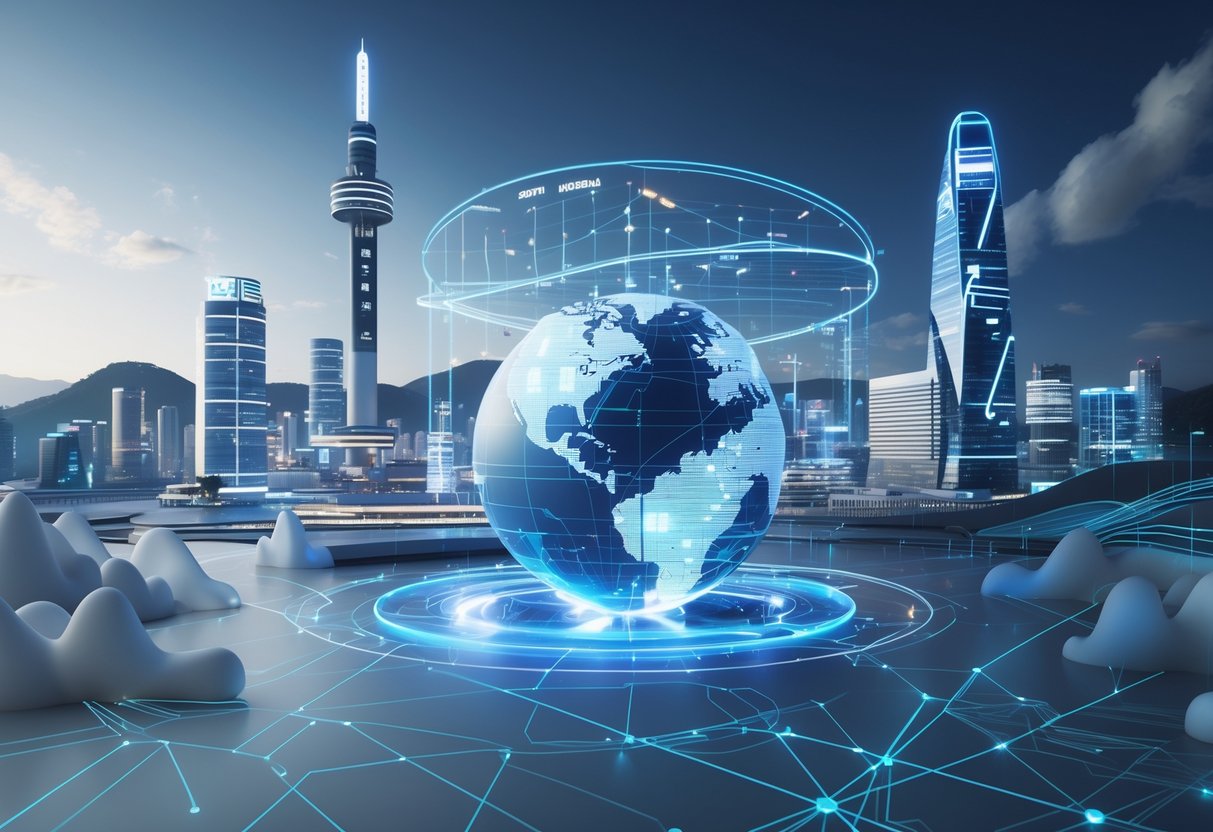
South Korea’s feeling the heat from regional rivals while dealing with economic uncertainty and rapid technological shifts. Political instability in 2024 has only made things trickier.
Managing Regional Competition
China and other East Asian countries keep raising the bar for South Korea. China’s pouring money into semiconductors and tech manufacturing.
That puts direct pressure on South Korea’s key exports. Chinese companies now churn out similar products, often for less.
Taiwan is another big player in semiconductor manufacturing. It holds a strong position in advanced chip production.
Hong Kong’s financial sector also competes with South Korea’s fintech scene. Both are scrambling for investment and talent.
Key competitive pressures:
- China’s massive manufacturing capacity
- Taiwan’s chip-making expertise
- Rising labor costs in South Korea
- Brain drain to other Asian markets
South Korea can’t win on cost alone, so it’s betting on innovation. This means more investment in research and development.
Companies like Samsung and LG are pushing into high-end electronics and AI. They’re choosing premium products and advanced tech over mass-market goods.
Global Economic Uncertainties
Growth slowed to just 1.4% in 2024, which was a letdown. Political turmoil and martial law shook investor confidence.
South Korea’s heavy export dependence leaves it exposed to global downturns. Exports make up 48% of GDP, so any global slump hits hard.
Trade tensions between the US and China complicate things for Korean firms. Many operate in both markets and face tough decisions.
Major economic risks:
- Domestic demand is dropping
- Export growth has slowed
- Trade protectionism is rising
- Currency swings cause problems
The semiconductor industry especially feels the ups and downs of global demand. It’s the country’s biggest export sector.
A lot depends on what happens outside Korea’s borders. International trade policies and the health of the global economy play a big role.
South Korea needs to branch out more. Building up the domestic market and reducing export reliance is key.
Adapting to Technological Change
Tech moves fast, and South Korea has to keep up—or risk falling behind. Artificial intelligence and automation are changing whole industries.
South Korea leads in 5G, but rivals are catching up in new fields. Quantum computing and biotech could be the next big things.
The aging population adds another layer of difficulty. By 2025, 20% of the population will be over 65.
Technology adaptation priorities:
- Integrate AI and machine learning
- Develop green tech
- Innovate in biotech and healthcare
- Expand workforce retraining
Schools and universities need to keep pace with new skills. Old-school manufacturing jobs are fading, replaced by tech roles.
Investing in emerging tech is a must. South Korea can’t just rest on electronics and cars forever.
The government has boosted research and development funding. Public-private partnerships aim to keep South Korea at the cutting edge.
Comparative Context in East Asia
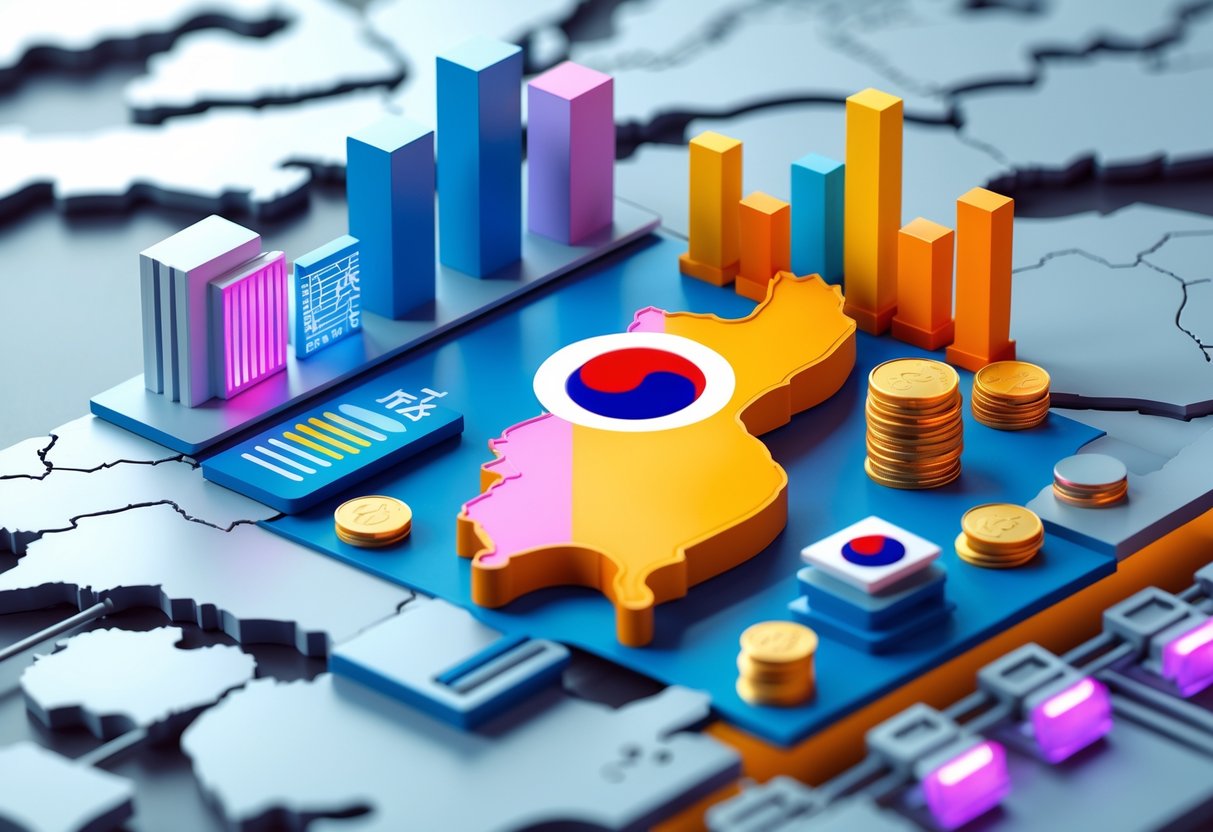
South Korea stands out in East Asia thanks to smart tech partnerships and bold diplomacy. Its approach to innovation and influence sets it apart, even though it shares some development patterns with neighbors.
South Korea and Taiwan: Technological Prowess
South Korea and Taiwan are two of East Asia’s biggest tech success stories. Both shifted from manufacturing to innovation powerhouses in just a few decades.
Key similarities:
- Big spending on semiconductor manufacturing
- Strong government support for R&D
- Focus on tech exports
- Quick move from labor-intensive to knowledge-based industries
South Korea leads in consumer electronics and car tech. Samsung and LG compete worldwide, while Hyundai pushes electric vehicles.
Taiwan’s TSMC is a giant in chip manufacturing. The two countries team up—Taiwan’s chips power South Korea’s electronics—forming a powerful tech alliance.
Both face pressure from China’s tech ambitions. They have to balance working together with protecting their own tech security.
Position Among Regional Middle Powers
South Korea has carved out a spot as East Asia’s most influential middle power. Unlike smaller countries, it shapes international conversations on several fronts.
Comparative middle power rankings in East Asia:
| Country | Population (millions) | GDP (USD trillions) | Global Influence Score |
|---|---|---|---|
| South Korea | 52 | 1.8 | High |
| Taiwan | 23 | 0.8 | Medium-High |
| Singapore | 6 | 0.4 | Medium |
| Malaysia | 33 | 0.4 | Medium |
South Korea wields cultural exports, tech innovation, and active diplomacy better than most regional peers. The global pull of K-pop, Korean dramas, and tech brands gives it an edge smaller countries just can’t match.
Sitting between China and the US, South Korea has unique diplomatic leverage. It can mediate tensions and keep good relations with both superpowers.
Frequently Asked Questions

South Korea’s dominance comes from smart government policies, massive education investments, cultural soft power exports, and relentless tech innovation. All these combine to create economic muscle and global clout.
What has led to the impressive growth of South Korea’s technology sector?
South Korea’s tech boom really took off because the government poured money into research and development. They set up innovation hubs like Pangyo Techno Valley, where startups and giants work side by side.
The chaebols—Samsung, LG, and others—played a massive part. They started small but invested billions and grew into global tech leaders.
Education made a huge difference too. South Korea built top universities focused on science and engineering, producing skilled workers who could build cutting-edge products.
Strong intellectual property laws protected inventors. Companies felt safe investing in new ideas, knowing their innovations wouldn’t get stolen.
How have cultural exports like K-pop and Korean dramas contributed to South Korea’s global influence?
K-pop and Korean dramas have put South Korea on the global map. These exports build “soft power”—people worldwide fall in love with Korean entertainment and often start buying Korean products.
That cultural pull helps tech companies win over global customers. When fans trust Korean culture, they’re more likely to trust Korean brands.
Entertainment also brings in big bucks through streaming, concerts, and merch. Companies like Hybe and SM Entertainment make millions from international fans.
Korean culture boosts tourism too. People watch dramas or listen to K-pop and then want to visit Korea in person.
What are the driving forces behind South Korea’s advancements in semiconductor manufacturing?
South Korea became a semiconductor powerhouse by investing heavily for decades. Companies like Samsung and SK Hynix built world-leading factories.
The government helped out with tax breaks and cheap loans, knowing chips would be vital for the future.
Education played a role again—universities trained thousands of engineers for the semiconductor industry.
Samsung and SK Hynix never stopped improving their factories. They always aim for smaller, faster, and more efficient chips.
Can you highlight the key policies that have supported South Korea’s economic progress in recent years?
The government’s five-year plans gave clear direction to different industries. This helped funnel resources into electronics, cars, and shipbuilding.
Export-friendly policies made a big difference. Special zones offered tax breaks to companies making goods for overseas markets.
Education spending stayed high, even when budgets were tight. That created a steady flow of skilled workers for high-tech sectors.
The “Creative Economy” policy encourages innovation across the board. It brings together universities, businesses, and government to launch new projects.
What role does education play in sustaining South Korea’s competitive edge in various industries?
Education shapes the workforce that keeps South Korea ahead. The country consistently lands near the top in global education rankings.
There’s a big focus on STEM—science, tech, engineering, and math. That produces the engineers and researchers who drive high-tech industries.
Universities often partner with companies on research, so students pick up practical skills that businesses need.
The government keeps pouring money into education, even in tough times. They know that smart, skilled workers are South Korea’s biggest advantage.
In what ways has South Korea’s geopolitical position affected its economic strategy and success?
South Korea sits right in East Asia, smack in the middle of major trade routes. That spot lets the country plug into global supply chains for electronics and cars.
Being close to both Japan and China? It’s a mixed bag. On one hand, South Korea trades with these huge economies pretty easily. On the other, it has to deal with some tough competition.
The country signs trade agreements to open up bigger markets. Deals with the US, EU, and other regions let Korean companies push their products all over the world.
South Korea’s location brings some real security headaches, too. The government juggles economic growth with defense spending and worries about regional stability.

